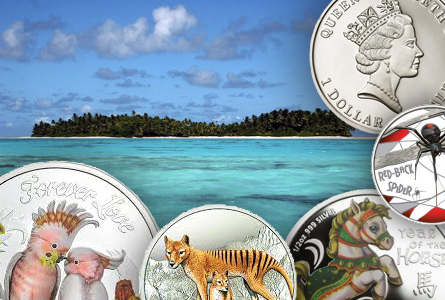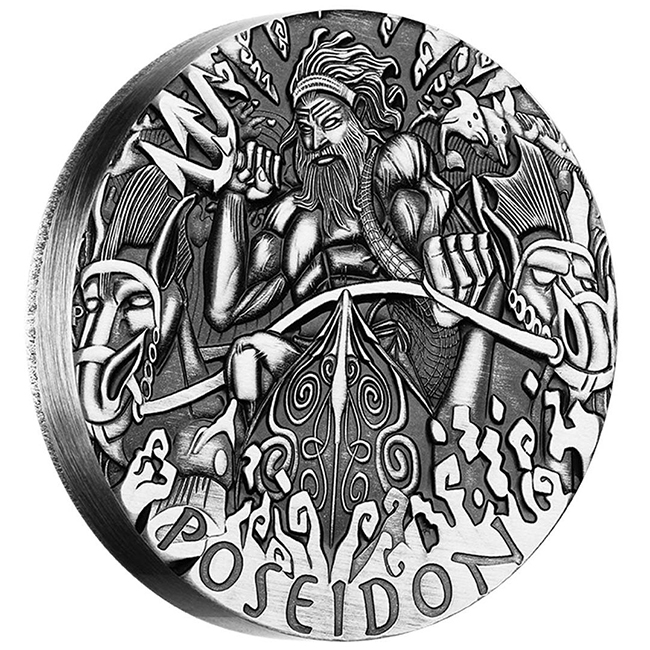By Ron Drzewucki – Modern Coin Wholesale …..
At first glance, it seems strange that a country like Tuvalu issues world-class commemorative and bullion coins. The big names (China, Canada, the United States, etc.) tend to be big countries, or at least have “big” histories (the United Kingdom, for one). Yet Tuvalu–one of the smallest countries in the world–not only releases such coins, but also puts American motifs by American designers on some of them.
I, for one, was curious.
Why Tuvalu?
Tuvalu (pronounced “too VAH loo”–and let’s get this out of the way now, you’re going to see this word a lot; it’s just plain fun to say) is the fourth smallest country in the world, covering a mere 10 square miles (26 sq km). Only Monaco, Vatican City, and the island nation of Nauru are smaller.
It’s located in the Pacific Ocean, about halfway between Hawaii and Australia, and consists of three islands and six atolls. The highest point in the entire nation is only 16 feet above sea level.
 The native people of Tuvalu are ethnic Polynesians, with origins in other island chains. Where, exactly, depends on which local version of the founding legend you accept.
The native people of Tuvalu are ethnic Polynesians, with origins in other island chains. Where, exactly, depends on which local version of the founding legend you accept.
And while the first Europeans to spot them were Spanish, the islands that would become the nations of Tuvalu and Kiribati (pron. “KEER ih bahsh”–look up why for some fun trivia!) became a British protectorate in the late 19th century. In 1976, the protectorate dissolved. In 1978, Tuvalu joined the British Commonwealth (now the Commonwealth of Nations) as an independent country.
Tuvaluan and English are the national languages.
Naturally, Tuvalu has strong economic bonds with fellow Commonwealth members Australia and New Zealand. So much so that its official currency is the Australian dollar, and between 1966 and 1976, Australian currency served as the circulating coinage of the islands.
With its independence from the protectorate in 1976, Tuvalu issued its first series of circulating coinage (though Australian coins continued to circulate alongside it). From the start, Tuvaluan coins were innovative and “fashion forward”. Each coin in the 1976 set features a different sea animal on the reverse and is attractively designed. Commonwealth coinage typically features the Queen’s portrait on the obverse.
And years before Australia and the United States did so, 1976 saw the introduction of Tuvalu’s copper-nickel alloy $1 coin, which also happened to be nine-sided. One wonders if it had any impact on the design of the future Susan B. Anthony dollar.
That same year, Tuvalu also issued silver $5 and gold $50 proof bullion coins–the start of what would become THE major part of that country’s numismatic output.
In 1994, Raphael Maklouf’s profile of Queen Elizabeth II replaced Arnold Machin’s design on Commonwealth coinage. This turned out to be the last year that circulating coinage was produced for Tuvalu, with Australian business strikes doing the job by themselves ever since.
However, Tuvalu continues to produce commemorative and proof bullion coins. The key to understanding why, I found, depends on two things: Tuvalu’s relationship and economic interdependence with its neighbor Australia and the idiosyncratic nature of the local economy.
“Not Intended for Circulation”
Detour time…
Several weeks back I wrote a defense of modern coins and the modern coin market.
It covered some of the arguments skeptics use to explain their disdain. I personally believe it boils down to fear of the new and being set in their ways, but their arguments deserve respect, and there’s no denying that the coin market–especially the market for World coins–has seen a glut of NIFC coinage over the last few decades.
To many detractors of modern coins, the acronym NIFC is a four-letter word.
It stands for Not Intended for Circulation, and any coin produced by governments for sale exclusively to collectors and investors can be considered NIFC. And, if you think about it, the fact that money is made that isn’t supposed to be used as money is a bit weird, if not disturbing. It suggests a Matrix-like, “red pill” kind of economic experience; after all, If money isn’t money, then what is money, anyway?
Still, I think the phenomenon is more a development of free market economics than a derangement, and as such shouldn’t inspire too much existential dread (though we should always –always– practice due diligence, as individuals and as nations).
And Tuvalu is one argument for why it might even be a good thing.
A Postmodern Economy
 So why is Tuvalu such fertile ground for NIFCs and Numismatics?
So why is Tuvalu such fertile ground for NIFCs and Numismatics?
The island nation is simply too small for industry and intensive agriculture, though it does export coconuts and taro. The people tend to rely on time-honored farming and fishing techniques to feed themselves.
Many Tuvaluans work in Australia and New Zealand and send money home. Many other Tuvaluans work as sailors on international craft and likewise remit their paychecks. On the islands themselves, many work in the tourism industry but most people work for the government.
The government of Tuvalu depends on a handful of external sources for its operational budget. There is the Tuvalu Trust Fund, which is funded by Australia and New Zealand. There is the Falekaupule Trust Fund, which is funded by the Asian Development Bank and the Tuvaluan government. Tuvalu also receives some aid from the United Nations and the Multilateral Fisheries Treaty (to which the United States is a party).
But this is where it gets interesting.
Besides their commemorative and bullion coins, Tuvalu is home to two other “unlikely” sources of income.
Most famously, Tuvalu earns over $2 million each year by leasing the rights to its designated higher-level internet domain name: “.tv”. To media companies in the U.S. and elsewhere, the appeal of having websites with the “.tv” suffix for your television properties is obvious. The domain is managed by Verizon subsidiary dotTV, of which Tuvalu owns 20%.
The island nation is also well-known for its stamps. The Tuvalu Philatelic Bureau issues stamps and first day covers for stamp collectors around the world. The Bureau issued its first stamps in 1976, the same year Tuvalu gained its independence and the first year the country minted bullion coins.
Which means that NIFC coins have been part of a larger economic plan since the country’s founding.
It also implies that someone in a position of economic authority–halfway across the world from the so-called centers of commerce-not only knew where the coin industry was headed before many in the hobby did, but also that there was enough money to be made in Numismatics that it could help prop up the GDP of a small nation.
(And this was the early to mid-1970s. No wonder the investors came sniffing around in the ‘80s.)
Therefore, utilizing its mighty mining industry and copious mint facilities, Tuvalu launched its long and fruitful career in coins and collectibles…
…except that didn’t happen. I already said that Tuvalu has no “industry” to speak of, yet it most certainly produces coins.
How?
The answer is simple.
The Perth Mint
Part of the confusion surrounding Tuvalu’s legal tender coinage is the fact that it’s made in Australia.
Specifically, Tuvalu’s coins are authorized as legal tender by the Tuvaluan government but manufactured by the Perth Mint.
It’s one of two working mints in Australia; the other is the Royal Australian Mint in Canberra, Australia’s capital. Founded in 1899, the Perth Mint originally refined gold from the Western Australia gold rushes of the 1890s and minted sovereigns for use around the British Empire.
Today, it handles the production of Australia’s gold, silver, and platinum bullion coins.
And like other major world mints (including the U.S. Mint), it also mints coins for other national clients, such as Tuvalu.
So, if you’re a fan of modern coins and haven’t yet swam in the vast waters of modern World coins, I encourage you to take the plunge. The swim is full of surprises big and small, coins that arrest you and command your attention. Coins that bring the world to your living room and invite you to expand your horizons.
An American Buffalo from a country called Tuvalu is just one such coin. There are many, many more.
-Ron





So, what about Cook Islands? Same thing?
Hi Ron- Awesome article! Thank you.
Tuvalu is in a precarious position due to global warming and rising sea levels. In a worst-case scenario, the islands would have to be evacuated. Would this lead to a situation where a physical country no longer exists but it continues to issue legal tender numismatic products? Postmodern, indeed.
@Joey Santiago:
Love your records and guitar playing. And I think the Cook Islands are similar, yes, but tax evasion is a much larger part of their economy.
An awesome article!